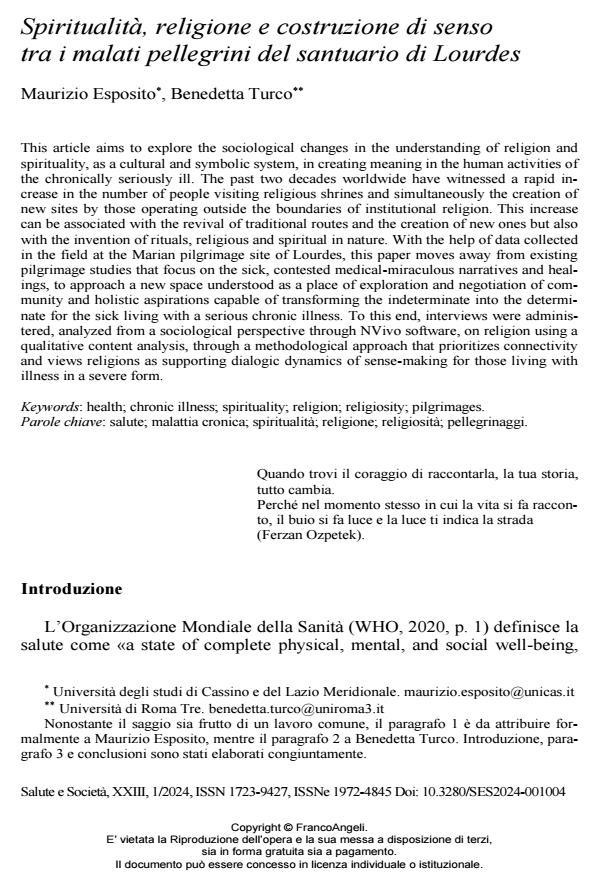Spiritualità, religione e costruzione di senso tra i malati pellegrini del santuario di Lourdes
Titolo Rivista SALUTE E SOCIETÀ
Autori/Curatori Maurizio Esposito, Benedetta Turco
Anno di pubblicazione 2024 Fascicolo 2024/1
Lingua Italiano Numero pagine 28 P. 37-64 Dimensione file 545 KB
DOI 10.3280/SES2024-001004
Il DOI è il codice a barre della proprietà intellettuale: per saperne di più
clicca qui
Qui sotto puoi vedere in anteprima la prima pagina di questo articolo.
Se questo articolo ti interessa, lo puoi acquistare (e scaricare in formato pdf) seguendo le facili indicazioni per acquistare il download credit. Acquista Download Credits per scaricare questo Articolo in formato PDF

FrancoAngeli è membro della Publishers International Linking Association, Inc (PILA)associazione indipendente e non profit per facilitare (attraverso i servizi tecnologici implementati da CrossRef.org) l’accesso degli studiosi ai contenuti digitali nelle pubblicazioni professionali e scientifiche
This article aims to explore the sociological changes in the understanding of religion and spir-ituality, as a cultural and symbolic system, in creating meaning in the human activities of the chronically seriously ill. The past two decades worldwide have witnessed a rapid increase in the number of people visiting religious shrines and simultaneously the creation of new sites by those operating outside the boundaries of institutional religion. This increase can be associated with the revival of traditional routes and the creation of new ones but also with the invention of rituals, religious and spiritual in nature. With the help of data collected in the field at the Marian pilgrimage site of Lourdes, this paper moves away from existing pilgrimage studies that focus on the sick, contested medical-miraculous narratives and healings, to approach a new space understood as a place of exploration and negotiation of community and holistic as-pirations capable of transforming the indeterminate into the determinate for the sick living with a serious chronic illness. To this end, interviews were administered, analyzed from a sociolog-ical perspective through NVivo software, on religion using a qualitative content analysis, through a methodological approach that prioritizes connectivity and views religions as sup-porting dialogic dynamics of sense-making for those living with illness in a severe form.
Parole chiave:health; chronic illness; spirituality; religion; religiosity; pilgrimages.
Maurizio Esposito, Benedetta Turco, Spiritualità, religione e costruzione di senso tra i malati pellegrini del santuario di Lourdes in "SALUTE E SOCIETÀ" 1/2024, pp 37-64, DOI: 10.3280/SES2024-001004